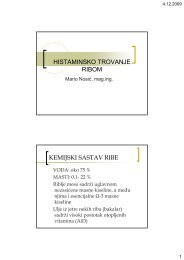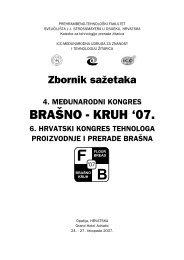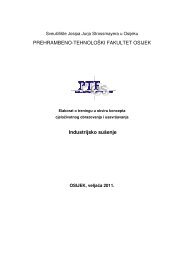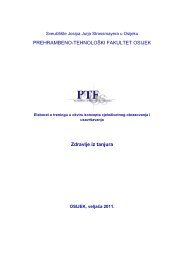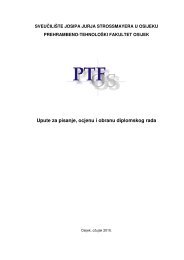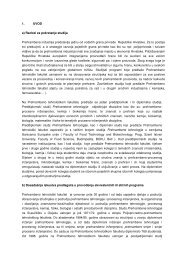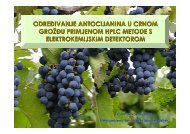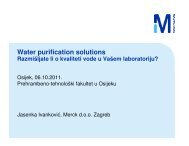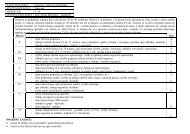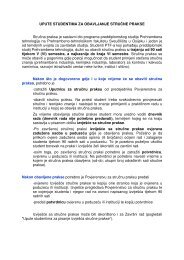ENGLISH IN FOOD TECHNOLOGY I
ENGLISH IN FOOD TECHNOLOGY I
ENGLISH IN FOOD TECHNOLOGY I
You also want an ePaper? Increase the reach of your titles
YUMPU automatically turns print PDFs into web optimized ePapers that Google loves.
ecome more important than ever amid the fierce competition now prevalent in the world<br />
wine sector.<br />
Champagne makers turn to finger-print technology<br />
1. Why is finger-print technology good for wine makers?<br />
2. What gives wines the specific character?<br />
3. Are bigger or smaller bubbles responsible for aroma and flavour of champagne? Why?<br />
Scientists have developed a method of finger-printing champagne, cava and other wines to<br />
prevent cheaper products being passed off as the more expensive varieties.<br />
Atomic absorption spectrometry was used to measure the concentration of 16 trace minerals<br />
in the champagne and cava. The results showed that nine of these could be used to give the<br />
wines a unique fingerprint that was different in the case of cava and champagne. Champagne,<br />
for example, contained 0.6 mg/l of zinc, roughly twice the amount found in cava. The trace<br />
minerals are taken up from the soil where the grapes are grown and soils from different<br />
regions have differing complex of trace minerals. It is the difference in the soils that is<br />
thought to give wines their character. The same method could be used to fingerprint many<br />
other wines to prevent fraud.<br />
Furthermore, scientists are still working on ways to perfect the bubbles, which according to<br />
experts are the key to the drink’s flavour and aroma. The smaller the bubbles, the better, say<br />
the experts. The reason smaller bubbles make better champagne is essentially because there<br />
are more bubbles available to release the flavour and aroma. The little bubbles pick up<br />
flavour and aroma molecule during their ascent, pulling them along until the bubbles literally<br />
explode onto the surface of the liquid, creating the sensory fireworks that are generally<br />
associated with a good tasting, refreshing champagne.<br />
Grape “x-ray” technology unlocks wine analysis<br />
1. What is “x-ray” technology used for?<br />
2. How will this technology help winemakers?<br />
The new machine, which looks like some sort of teleporting device, uses a process similar to<br />
that used by x-ray machines to probe the content and make-up of grapes. It then takes seconds<br />
to send detailed information on colour, acidity, sugar content and maturity to an adjacent<br />
computer screen, where the user can see the results on a range of handy graphs. This will help<br />
winemakers to give consumers what they want. For example, consumers want certain aromas<br />
and the best ways to get this is by following the colour.<br />
New technology keeps wine fresh<br />
1. How can wine be preserved in open bottles?<br />
2. What technology was applied in the past?<br />
3. What are the advantages of the new technology?<br />
A hi-tech way of preserving open bottles of wine from oxygen contact could prevent<br />
consumers and restaurants from being afraid to open better bottles of wine. The new device<br />
38



